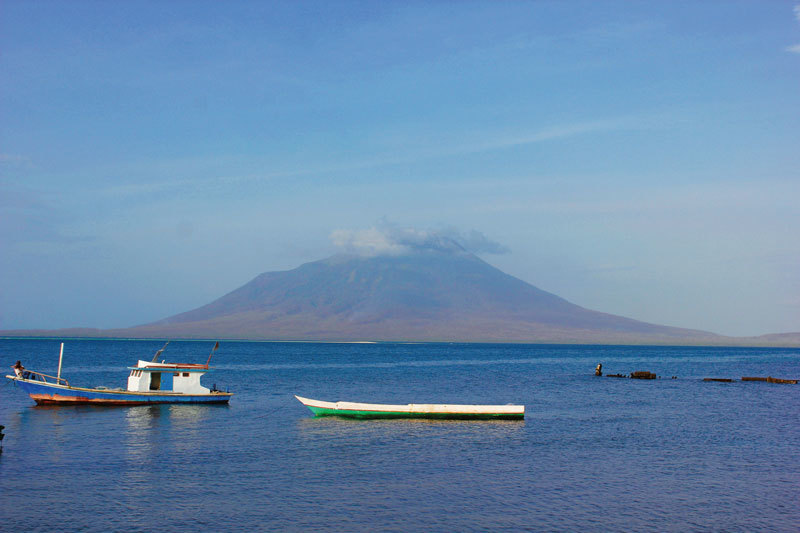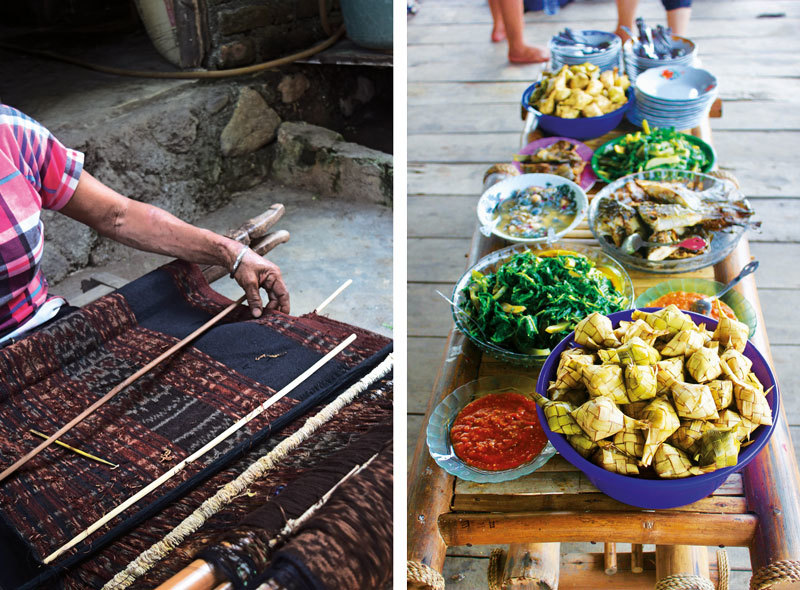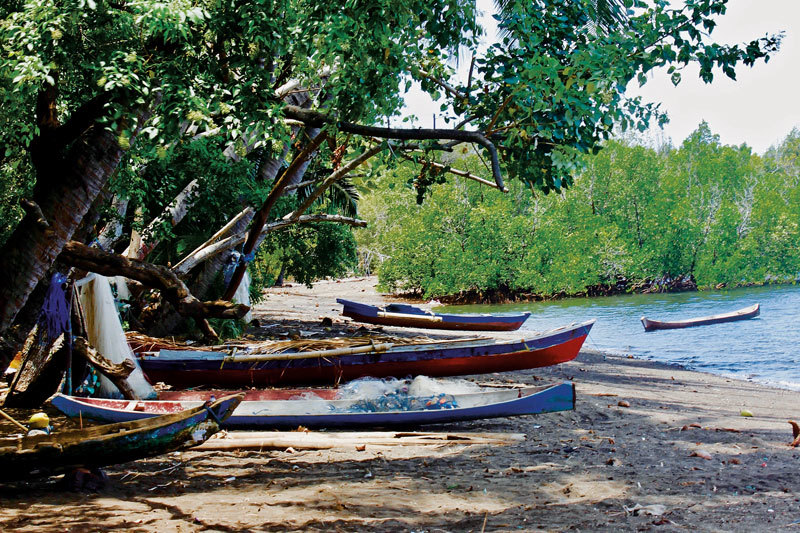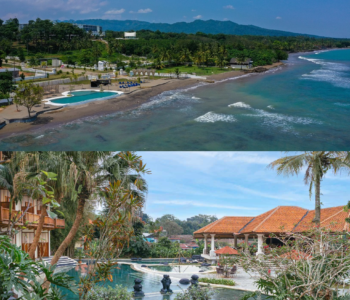Sitting between Timor and Flores, Lembata is the largest island in the Solor Archipelago. Small villages dot the landscape, and tourism is still very low-key.

The island has a rich tradition of weaving using natural dyes. Village life often seems to move to the gentle click-clacking rhythm of the weavers at their looms. The local people are from the Lamaholot ethnic group, and have their own language. They are incredibly welcoming of visitors and, if rustic off-the-grid travel appeals, it is worth seeking out this treasure tucked away in the far eastern reaches of Indonesia.
My first stop in Lembata was to visit Kristina, a master weaver and dyer who is part of a local weaving collective of twelve women. “Weaving is our art and brings us together”, she said. “We weave together, and plant and harvest together to supply the cotton and all that we need for the natural dying process”. She went on to explain, “To get the rich colours we use recipes which have been perfected over hundreds of years”.
The cotton is hand-spun and dyed by the weavers. The morinda root creates the rich red colour. Other natural dyes are used, including indigo for a blue to blue-black colour. The women produce unique creations with varied motifs including human figures, animals and plants. Katrina explained, “I love to weave the motif of the Kugupungan. This is the flower of the tree that you find all over our island. This tree is also used to make the pillars in our traditional houses”.

I had heard that the marine environment around Lembata is exquisite. So, after visiting Kristina, I next went to nearby Tapulangu Village. From there I took a small traditional wooden boat to a tiny island called Nuhanera, or Ancestor Island. The crystal-clear waters and lovely white sand beach that fringed the small island offered an idyllic spot for tropical relaxation, and snorkelling amongst yellow striped angelfish and pastel rainbow fish.
The boatman told me that, mysteriously, turtles come by the island every day on cue at 1.00 pm. I could not stay to check this out, however, because I had a date on the mainland where I was told a ‘surprise’ had been organised.
When the boat pulled up on the beach, I was greeted by a dance troupe from the local village. They were all lined up, dressed in traditional ikat (woven fabric), eagerly awaiting me. It is so low-key in Lembata that when the word spreads that there are visitors on the island the children run around in a flurry to rehearse and put on a performance, as they love a new audience.


After watching the beautiful dance, I was invited to lunch. There are no restaurants in this part of the island, so a meal was prepared and served by the local women on a makeshift platform under a tarp erected for the purpose. There was an elaborate spread, including an array of fish and vegetable dishes. I particularly enjoyed the steamed cassava cooked in a bamboo tube and the gorgeous coconut and palm sugar dessert. This opportunity to mingle with the villagers offered me a unique insight into the cultural and social life of the island.
I believe every place is a school, every moment is a lesson, and everyone is a teacher. The locals had been so generous with me, and now it was my turn to offer something in return. So after lunch, I rolled out an English song, “Days of the Week”, and got the children who gathered around in great numbers to join in. I then taught them the crowd pleaser, “Head and Shoulders, Knees and Toes”.
This went down a treat and caused great hilarity! They then surprised me by singing a Catholic hymn in English, an impressive feat since English is not taught at all in elementary school. This little band of 7 to 10-year olds explained that they love to learn English through the local church.
The next day I had a 2.30 am wakeup call. I took a boat trip out across the expansive dark sea to catch the sunrise over Mount Batutara, also known as Batatar, on Comba Island. As the first rays of dawn awoke me from my slumber on a padded bench on the boat, I clambered to the upper deck and caught sight of an incredible phenomenon.
The smouldering volcano on Comba Island was alive and puffing, and very close indeed. This was both exciting and a bit scary. I persuaded myself that, being offshore, any lava that might flow from the active volcano would slide into the ocean and not reach me. Beyond that, I always maintain “locals know best”, so soon settled down to enjoy this magnificent sight, and was able to appreciate the stunning sunrise. Ultimately, it was well worth the crazy wakeup time. One thing is for sure, a Lembata trip is an adventure.
Back in the village again, I decided to do a little more exploration of Lembata by land. Crossing the island, which is only 30 km wide, takes a long time. I travelled in an open jeep type bus along “roads” which were not strictly speaking roads at all, but more like tracks. There is a minimal selection of vehicles on the island, so you need to book well in advance with a local guide, who will arrange everything for you and secure the best available car at the time.


A trip to Lembata is not complete without a journey to Pulau Siput, also known Snail or Awulolong Island, only 20 minutes from the main town of Lewoleba. At low tide, this sand bank island is exposed, and you can go beachcombing for unusual seashells that that are often there.
My timing was perfect as I got to witness sunset on this thin stretch of sand in the middle of the ocean.As we sat there waiting for the water to again claim the island, my guide told me an enchanting tale about it. Before he started, he explained there are a few versions of the tale, but all have a dog at their centre.
“This was once a village here, now long lost”, he began. “The village held a party with traditional dancing and the leader of the party, an old woman, prepared betel nut as part of the welcoming ceremony for a special guest. Everywhere she went a village dog kept following her. She became angry and told the dog, “Because you keep following me take this betel nut and give it to the guest. The dog obeyed. After that, a tsunami wiped out the island. It disappeared and became a lost island because of the dog. Nowadays, it is forbidden to say the word ‘awulolong’ when visiting the island because it represents the sound of the dog in Lamaholot culture. The tsunami is said to have occurred some 500 years ago.
As the sun set, bathing us in soft, delicate golden hues, my island began to disappear. Soon I found myself floating, with no land in sight. It was time to board the boat and return to the mainland to prepare for my onward journey.
A truly fascinating experience awaits you at Lembata with beautiful ikats, snorkelling delights and a rich community life in one of the lesser known islands far to the east.
Tour Guide
Miss Ella – Weaving Tours
E: lebanella@gmail.com
T: +62 813 382 288023
Accommodation and Tour Guide
Nuhanera (NN) Lodge
Bamboo Eco Resort & Dive Centre
Waienga Bay, Lamawolo Village, Lewolaba,
Lembata Island, NTT
http://www.booking.com/Share-V6kFKPq
Mr Tonny Lebuan – Guide and Resort Owner
E: pulaulembata@gmail.com
T: +62 813 3710 0089
_______
This article is originally from paper. Read NOW!Jakarta Magazine September 2018 issue “Music and Nightlife”. Available at selected bookstore or SUBSCRIBE here.







